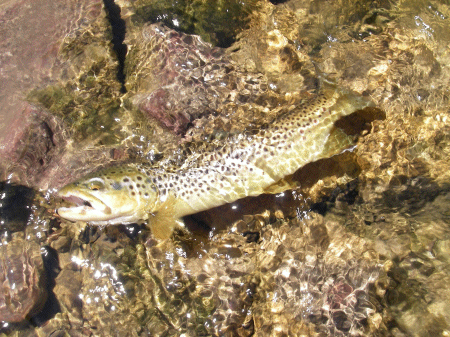 River
flows are more or less back to the normal 800 c.f.s. with some modest increases
as the day progresses.
River
flows are more or less back to the normal 800 c.f.s. with some modest increases
as the day progresses.June, 2007
6/11: So far our June fishing experiences have been a complete bust. The month came in like March is sometimes supposed to - like a lion - with too much rain, cold temperatures, wind, snow, hail, etc. Today the dog & I drove to Dowd Junction and threw a wooly bugger along the riprap for maybe an hour. Both the Eagle and Gore Creek are still at runoff levels though water clarity is very good.
I had a pretty normal number of "annoyance" strikes from the local browns but only hooked and played a single fish that was around fourteen inches long. The black streamer worked better than either olive or brown types but nothing was particularly effective.
Tomorrow we head back to Granby to try some deep full sink line plus diver device in the hopes of finally connecting with maybe a lake trout or larger rainbow. Then we'll wade the upper Colorado for a while before driving back to Williams Fork Reservoir for some more trolling the next day.
6/12-13: Another bust. Some kind of early monsoon flow blasted up from New Mexico and completely drowned us today and absolutely for tomorrow. The ugly weather is simply amazing. There's no possibility of fishing either rivers or streams under these conditions.
Thursday we'll leave around the noon hour and drive to the pass above Flaming Gorge to camp for the night and hopefully will have at least tolerable conditions on the Green below the dam on Friday.
6/14-17:
What a week. The plan had been to test a couple of local reservoirs - Granby and Williams Fork - on Monday and Tuesday and then head back to the Green over the following weekend. As has been the case all spring and early summer, relentlessly bad weather reared its unpleasant head again with monsoon-like rains drowning any thought of getting outdoors those days.
Fortunately the forecast had improved dramatically when I headed out towards Utah after lunch on Thursday. This was a loner trip, as the dog decided to accompany Sue on her weekend trip to Montana to do some home decorating with an old college friend.
Arrived at Dutch John late in the afternoon and debated where to get in couple of hours of casting before hitting the hay for the night and decided to drive to Little Hole to walk a bit of the upper part of "B". A couple other people were casting along the shore so I hiked down to a small island and began casting in the riffle just above it.
Amazingly smaller rainbows immediately began taking the #18 WRS despite no hatches being evident. It was fun. Obviously most of the fish were recent stockers, but a nice fourteen incher actually fought like a wild fish. Probably played a good dozen trout in this stretch, all of which were bows.
Got up quite early the next morning assuming there would be good numbers of people hiking up the river between Little Hole and the dam, but that turned out to be not the case.
Put a simple lunch in the backpack and started walking upstream around 7:30. It was great having the whole river to myself. With cicadas still apparently at a relatively high level of emergence I stuck with that pattern all day. Initially I tried trailing the cicada with a variety of nymphs, but as all those latter flies seemed to be universally ignored, eventually I stuck with either a single cicada or doubled up that pattern (more on this later).
 River
flows are more or less back to the normal 800 c.f.s. with some modest increases
as the day progresses.
River
flows are more or less back to the normal 800 c.f.s. with some modest increases
as the day progresses.
The fishing was really, really good. In the first hour & a half of casting, I was able to test three different styles of cicada. (see the fly tying page).
On these very difficult fish the best version by far was a black rubber leg version with either a turkey feather or medallion wing. The orange/black centipede leg model was next, followed by a mottled orange thin skin winged last. I tried a couple of the local commercial types with no success and gave up on them.
By the time I hit Dripping Spring at 9:00, I had actually stopped trying to hook fish. It was just too easy. After that point for the rest of the day I either just let the fish mouth the fly or actually removed the hook & barb to see how many strikes would occur. It was, however, essential to use the most realistic pattern - and even that one did have lots of refusals by fish that would swim directly below it and stare at it for several seconds before making a feeding decision.
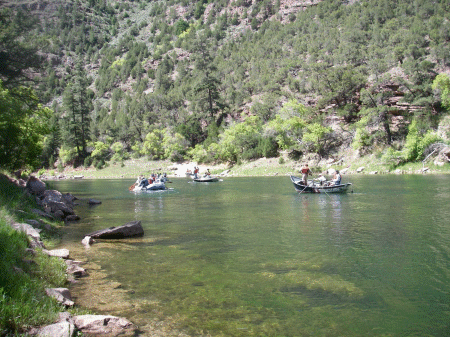
The 10:30 daily B.W.O. (boats with oars) hatch. Lots of tourists and kids this time of year, but most are reasonably polite to other boaters and shore anglers.
So it was a fun day, albeit with fish that have very little spunk in their fighting ability.
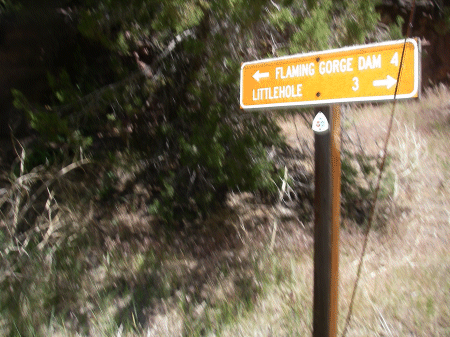
Most of the way up the trail along the Green above Little Hole. It's amazing how many fishermen walk the trail this far upstream - in full waders. I can't imagine how uncomfortable they must be by the end of the day. Unless the air temperatures are brutally cold, there's no good reason to hike the trail in anything but shorts and wading sandals.
My favorite section is just below the four mile sign. Larger fish and no competition for them if you get there before the flotilla of drift boats arrives around the noon hour.
Later in the afternoon I drove to Flaming Gorge and down the dirt road to our regular primitive camping spot down on "rattlesnake point".
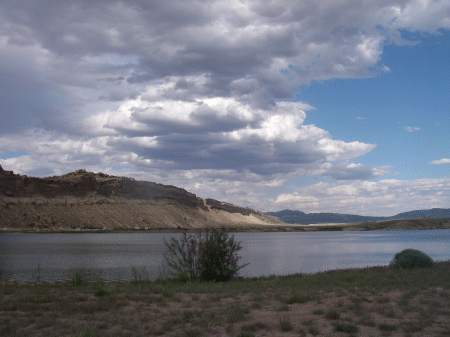
Flaming Gorge in the early evening. After a brutally hot day, the cloud cover was a blessing.
Put the kayak in the water and did a bit of shoreline trolling before dinner with zero success. Not a good portent for the next day or so I'd planned to stay here.
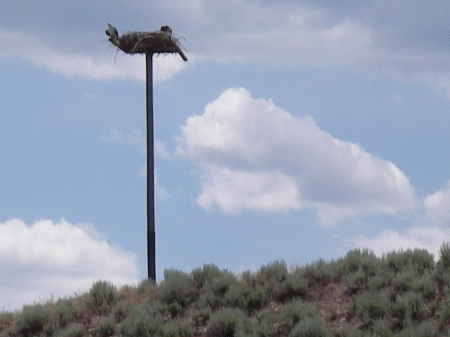
A couple of nesting ospreys on an artificial stand on an island in Flaming Gorge.
After dinner the fishing was strange but simultaneously unusually great. It was just a bizarre experience. There was a tiny arm of the lake at one side of the point where I was camped that looked fishy but previously never had held anything prior to this trip.
I walked around the end of it (carefully watching for rattlesnakes) to find an open spot to cast through the shoreside tamarisks, and upon finding an opening, also saw a bunch of smallmouths and carp milling around the end of the arm.
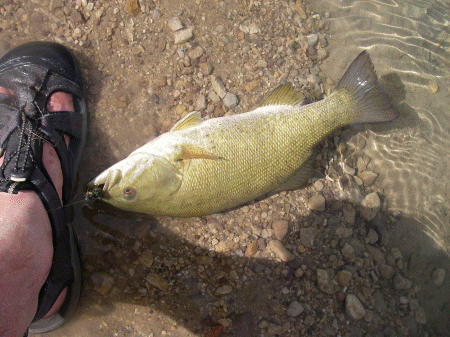
Casting a gold eyed olive bugger brought instant strikes. The bass literally went wild for the fly. Absolutely astonishing behavior on the part of fish that should have been reasonably cautious.
It was as though the fish had never seen an artificial lure before. In the space of a half hour I'd guess releasing 20-25 nice bass between 1-3 pounds.
What an evening. Never have seen anything like it. Also hooked but didn't land three very large carp that were for some unknown reason also attracted to the bugger.
Next morning there were no fish in the arm. Go figure. My guess is that the bass and carp may be attracted to locations like this when the shoreline gets stirred up by boats and perhaps they enter the arm to stalk prey when the water gets cloudy.
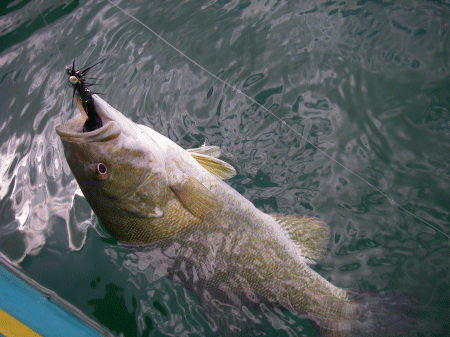
Trolling this day - either deep with the diver - or just using the standard sink tip line - brought a few fish now and then.
It wasn't really productive, nor as much fun as it usually can be. Maybe the trolling approach we're using is just trying to stretch fly fishing - as a form of fishing - too far into places where it does not belong.
At the same time I know we pretty much need an alternative to stream casting when the rivers are blown out by runoff.
That was it for the kayak fishing. It just wasn't much fun, so rather than spend another day at that same relatively unproductive activity, I packed up, drove off the lake and down the back road to the bottom of the B section in the hopes of finding a few of the decent sized browns that swim below the Jarvie camp area.
Hiking to the water below the bridge, I ran into another couple of people working their way upstream, so I made a few down river casts with a hybrid gummy/marabou minnow fly in the hopes that its small rainbow appearance might be interesting to the cannibalistic browns. So guess what took the fly. Small rainbows. Didn't know little ten inch rainbows were cannibals, but I guess these stockers were simply young fish stupid.
Drove back up the road and across the bridge and started working my way down the opposite side with the same fly and came up with the same results. At the bottom of the good run, I turned around and started back up the same side but changed to a leading orange/black legged cicada and trailing black copper john. This meant casting off handed all the way upstream which is fine, but my line control is pretty lousy from the right side. So while I had a bunch of strikes from various fish, I managed to miss the first eight or ten.
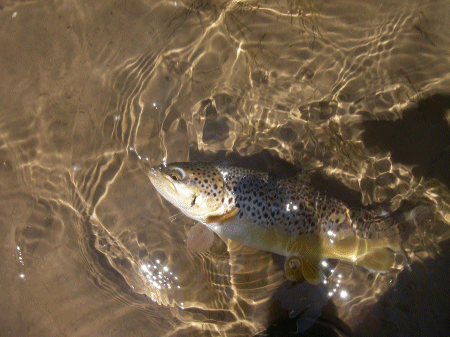
Eventually a couple of very nice browns came to the cicada and made the afternoon a relatively successful outing.
It was too early to stop and camp for the night so I drove further down the road back to Colorado into the "C" section of the Green and eventually pulled off on one of the dirt roads leading back down to the river.
I'd never fished this section previously, as it always not only looked lousy due to wide shallow flows, but it also runs very warm and simply does not by reputation have many fish.
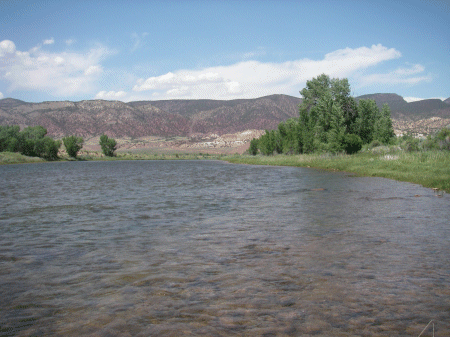
A photo of the upper part of the riffle that was so productive on the "C" section. It's a very Montana looking type of stream down here. Reminds me of parts of the Madison near Cherry Creek.
The water was shallow and the river could be waded across in most places, but the fish seemed to be holding either below some micro structure or on the edges of deeper runs.
Boy, what I've been missing by not casting down here. It was great fishing! Same cicada fly that worked all day long. Caught at least fifteen very nice, very strong browns in a stretch of riffle water. Wonderful fish. Ranged in length from a pup of ten inches to a massive male of roughly twenty. Lost a couple possibly larger fish that simply sawed the tippet off. After that I turned to a 3X tippet. This section was a great find. As Arnold would say "I'll be back".
It was a long day that continued to get longer. Drove back into Colorado through Maybell, then took the back road to Meeker and on to our favorite stream. It's not in bad shape although still in flood and tough to wade. Arriving at my camping spot by the river, lots of hatches were in the air, but there was no sign of fish coming up in the water. Several caddis types, a mayfly or two, and several midge species were active. Tried an hour of casting and had zero strikes.
This morning I drove to our favorite water and threw all kinds of attractors and nymphs walking upstream with - again - absolutely no strikes.
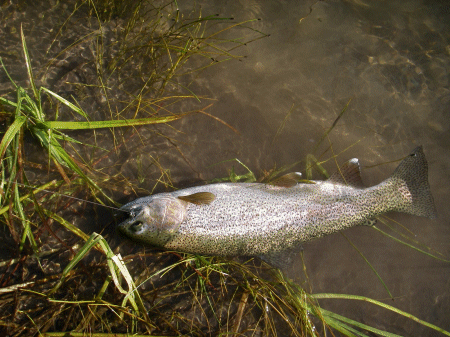
Changed to a black estaz bugger and eventually landed a pair of fat rainbows between 14-16 inches, and that was it for the trip. This river won't really be nicely fishable for another 2-3 weeks.
OK. Some last comments on cicadas (which fly may be an obsession with me). At least on the Green River below the dam in the "A" section the fish are enormously finicky where this pattern is concerned. A bit of orange tinge is necessary. Too much orange coloration is detrimental to the overall appearance of the fly. Solid black rubber legs are far better than mottled orange and black.
A more realistic winging material is infinitely better than bleached elk or deer hair. Smaller hook sizes seem to work better than larger. A somewhat smaller imitation may also pass for the indigenous crickets and beetles as well as cicadas.
Below the "A" section the orange and black leg models were just as effective and were far easier to see on the water, and it was clear that the less heavily cast over fish down there were not nearly as fussy.
6/20-21: These two days fall into the category of "half empty or half full" fishing experiences. With streams still raging with runoff and pretty much blowing out due to extremely hot air temperatures, our opportunities are limited to either tailwaters or stillwaters.
So the dog and I exited our condo for a repeat of the Lake Granby/Williams Fork reservoirs that we tried I believe back in May. Before putting the kayak into Granby I drove to the outlet of Shadow Mountain to see if that "tailwater" had reduced its flow to a more fishable level. It was not the case though the water was somewhat more workable than the last time we were here. I tried black streamer-ing my way down one side below the dam and really had no strikes at all. At the turnaround point changed to a surface white rubber leg WRS and a three foot trailing #18 red copper john and started back up.
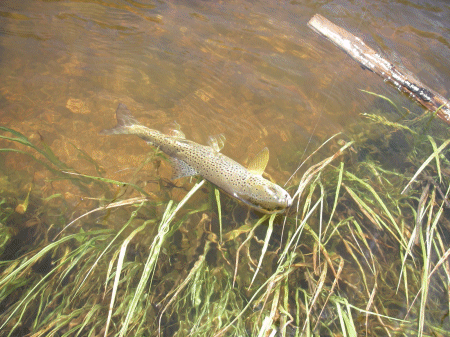
This turned out to be a decent combination as fish came fairly equally to both flies. With the exception of a couple of rainbows in the 14-15 inch range that "long released" after being hooked, all the rest were smaller browns under twelve inches and probably a dozen fish were released in a short period of time.
Walked a bit further downstream to the spot I'd hooked a very large fish on the last trip and had no success this time at all. Tried a PMD (which hatch was ongoing) without success and did hook a handful more fish on a tiny unweighted prince. After that we drove to Granby and started trolling near the surface with just the full sink line and a couple of streamers.
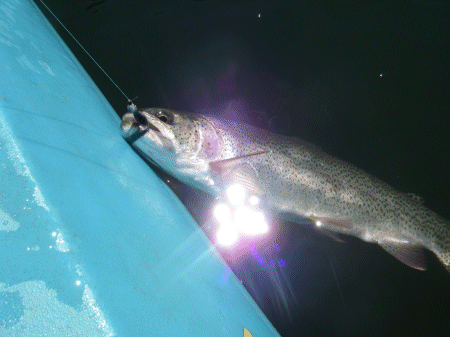 It wasn't great, but
I did release a couple of twelve inch rainbows before again attaching our
"diver" device and going much deeper.
It wasn't great, but
I did release a couple of twelve inch rainbows before again attaching our
"diver" device and going much deeper.
Eventually I did get some strikes and released one decent bow of about fifteen inches, but this didn't qualify as much of a successful trolling excursion either.
On the way back towards the Williams Fork we stopped just below Hot Sulfur Springs to try the Colorado. It's very high and quite colored and I had only one - whoops two - fish on. It was kind of a strange situation. Was deep nymphing with a stone and prince and hooked a tiny rainbow, maybe five inches long. As I was adjusting some slack to get the fish in to release, all of sudden the fish morphed into a larger rainbow of a good sixteen inches or more. Couldn't believe it. We're used to browns trying to devour any small rainbow in sight, but this was the first time I've experienced a large rainbow doing the same thing. Anyway as I was pulling the larger fish in, it saw me and spit out the small guy, which miraculously was still alive when I released it.
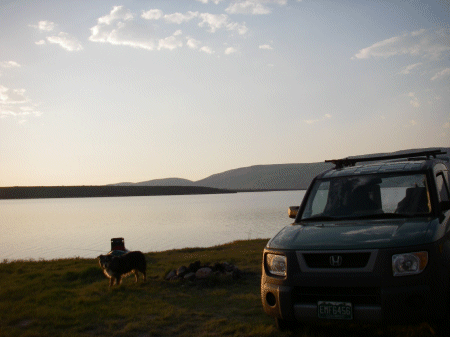 OK. On to the
Williams Fork.
OK. On to the
Williams Fork.
We set up camp, had dinner, and trolled for a couple of hours. Zero, zip, nothing. Got out on one of the arms and did catch a couple of foot long rainbows, but the trolling stunk.
Next morning it was another blank repeat for two more hours. Finally loaded back up the boat and drove a mile or so t a shallower, weedier area of the lake hoping for some pike.
Saw all kinds of them in the water ranging from 1 1/2 feet to over 3 feet long, but had no strikes for another couple of hours of paddling.
Very discouraging. I think the main issue with trolling streamers as we do is that they simply don't show much animation despite being tied with either marabou or rabbit strips.
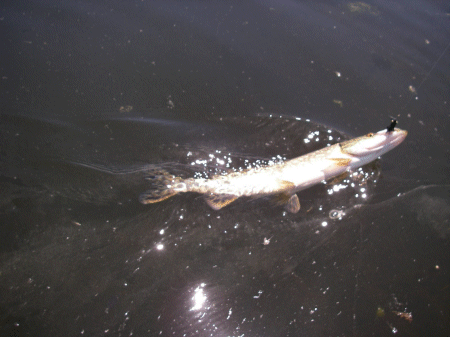
Just before packing up again, I did try a different tactic that worked - slightly. Put the full sink rod away and rigged up a single streamer at the end of my floating line rod, the paddled back and simply did some casting with either a black streamer or a gummy minnow.
This worked a bit better as I had a few strikes, a couple of break offs (no steel leader) and did land a couple of smaller pike.
I'm going to try to work up a short length of metal leader that hopefully will not be obtrusive and maybe go back to W.F. again this weekend. There's no question that these northerns are somewhat leader shy and they definitely go off their feed if they see a boat passing near them - so they're not dummies by any means.
Last Logbook Entry � for previous day
6/27-28: This was supposed to be a three day trip but was shortened by a day when I once again flunked pike. More on that later.
Some of our streams are dropping fairly rapidly while others continue to flow at late runoff stage rates, so my trip was kind of a combination of still waters and whatever streams might be somewhat more approachable. The dog's again laid up with a shoulder injury and can't jump in the car so it was better that he stayed home this time around.
Did a pretty long drive to start the trip, traveling roughly three hours on U.S. 40 towards Walden in North Park and turned East at Rand to the shortcut through the mountains to Gould and then up and over the pass to where the Poudre River has its headwater. Just over the top of the pass are two lakes, one of which we've previously visited (& which name I can't remember at the moment.) It's a recovery lake for greenback cuts but is currently undergoing poisoning to remove trash fish, so is not accessible at this time.
The second lake just below it is a reservoir called Joe Wright. Supposedly stocked with an odd strain of rainbow - the Emerald Lake variety - which I've never heard of before, plus grayling (which I've never caught) and apparently a couple types of other cutthroat. So never having tested that lake, it seemed like a good place to start the trip. No motors are allowed - which is good for me. I dragged the kayak to the water and began trolling along the shoreline.
As so often seems to be the case, I just don't do stillwaters well - particularly trolling. Paddled halfway around the lake with zero strikes until finally seeing a few rise rings on the surface. Some kind of fish was taking emergers - probably chironomids or callibaetis - which I guess are present in most of our lakes. With my dry fly rig in the kayak, I set up with a generic #18 gray bodied WRS trailed by a version of what was supposed to pass for the callibaetis nymph.
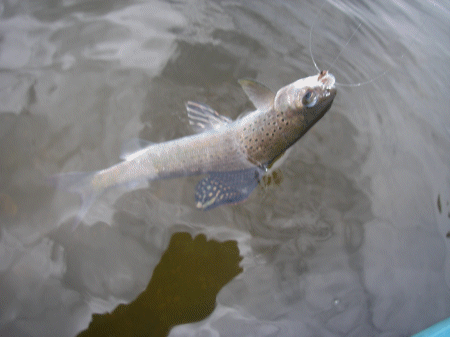
Fairly quickly strikes started coming to mostly the surface fly. The resident grayling were not very bright, nor were they very large, but it was a whole lot better than getting no strikes at all. And most fun of all, it's a new species for me.
Best results were had when a single fish could be spotted feeding but for the most part, just drifting near the shore and casting in front of the boat brought decent numbers of strikes.
Even landed & released a double. The grayling seemed to have quite soft mouths. A couple of the larger ones hooked just pulled loose after a few seconds of struggling. The biggest were in the fourteen inch range - most were 10-12.
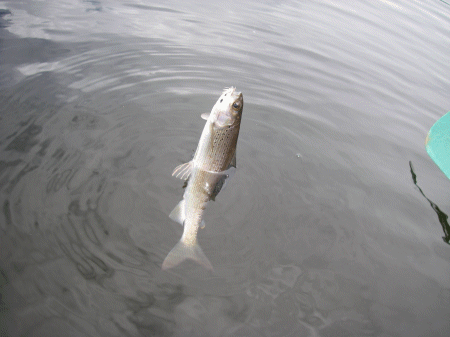
They're very pretty fish with the big dorsal fins. Not much struggle to them and they look more like whitefish than anything else.
At a certain point the thunderclouds turned a bit ominous, the wind sprang up, and I opted out of trying to hook any of the other unusual fish supposedly swimming in this reservoir.
Drove down to and parked by the head of the dam to see what might be flowing out in the form of a tailwater, but the released water was on a pitch so steep, it seemed impossible that any fish could hold in that raging current.
W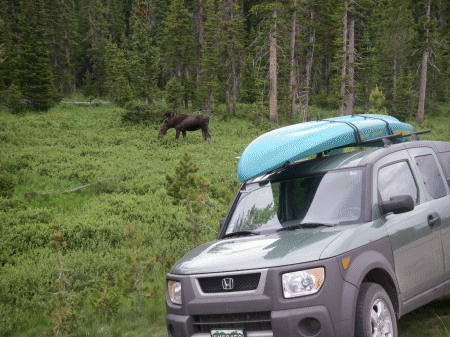 hen I finally hiked back to the car, there were
two moose - a mom and calf feeding just beyond it.
hen I finally hiked back to the car, there were
two moose - a mom and calf feeding just beyond it.
Coupled with the juvenile bull moose I saw at the upper end of the lake, I had now encountered more animals than people up here. So much for Joe Wright.
Loaded up the boat and headed back over & down the pass back towards Gould. Turned off the highway and looked at the South Fork of the Michigan River (given its small size, labeling it a river is a misnomer), but it looked way too marshy and slow so I continued on to the reservoir at the North Fork of that same named river.
Fishing the tiny inlet and outlet of this also smallish reservoir was just outstanding. Runoff is completely over here and the flows may be literally in a four to five cubic foot range. Both streams are really tiny but both are loaded with fish - all rainbows this time around, although I've caught several browns here in the past.
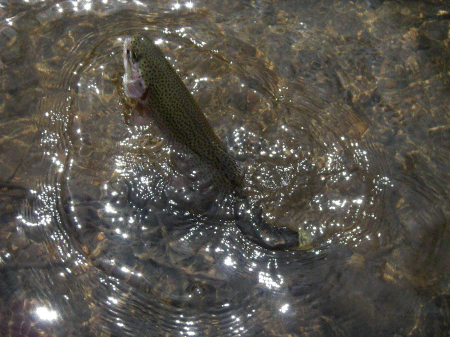
While the bulk of the trout were in the eight to ten inch range, I did release a few from twelve to fourteen, which seems amazing given the aforementioned modest flows.
Virtually every decent fish was hiding beneath an undercut bank, so casting in these tight quarters requires a willingness to accept some hangups with lost tippet & flies.
A double fly rig of dry and bead head nymph are essential to cover all the places where the fish may be holding.
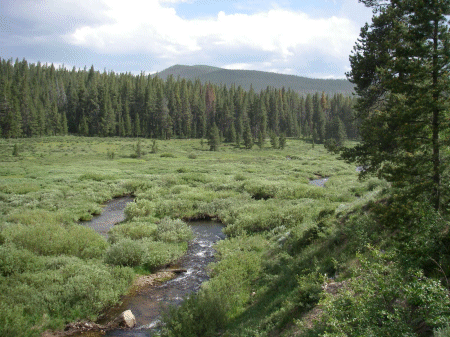
The main caveat to fishing here is that the stream moves through a wetlands and extreme caution is needed when walking through the willows due to many holes and drop offs in the meadows around the water. It's also very buggy - at least this time of year.
Did have another interesting, albeit somewhat disturbing wildlife incident happen just as I was finishing up.
On the hillside just above the stream - although out of sight from me - I heard a series of terrible shrieks. Shortly a doe and a yearling came running for their lives down the hill. Logic suggests that the cries were from a sibling deer that had just been taken by a lion. Lions are scary critters for all of us - much more so than was the black bear that strolled across the road twenty feet in front of me this morning on my run up our mountain here in Vail.
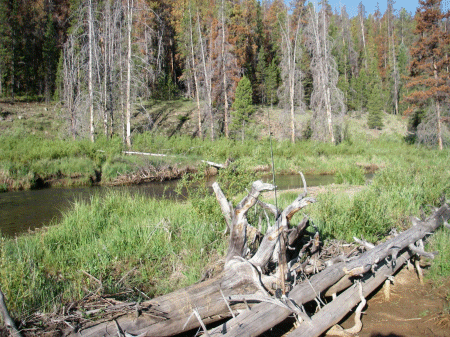
Later in the day I headed back over Willow Creek Pass towards Granby and pulled off for the night at one of many primitive parking areas by the creek of that same name.
Have never had much success on this creek in the past, probably due its extremely low flows when I've tried it before.
This time of year it's in much better shape and I did have some success this evening on small rainbows in a nice run across from where I was camped.
Had the obligatory cup of coffee mixed with hot chocolate the next morning and did a bit more fishing on the same stream. It wasn't great, but I did manage to release a few more rainbows under ten inches. With frost on the roof of the car it was also a bit chilly going and nippy on the toes wet wading this early in the day. It still was interesting to find that the trout would feed both on the surface and below during very early morning hours.
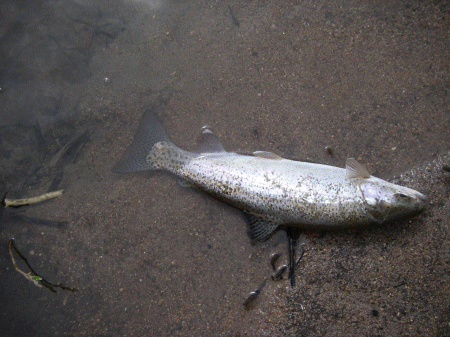
In fact the photo of the this rainbow was taken in such low light that the flash actually went off when the picture was taken.
Back to Granby I drove, stopping there for a quick omelet before heading back up the highway towards Rocky Mountain Park, pulling off at the base of Shadow Mountain Reservoir's dam and rigging up for a short visit to this unusual "tailwater".
This short run of stream between the previously named lake and Lake Granby doesn't really qualify for the moniker of tailwater, but it is very interesting fishing. It's also worth noting that there are very few, if any, regularly published reports on this piece of water.
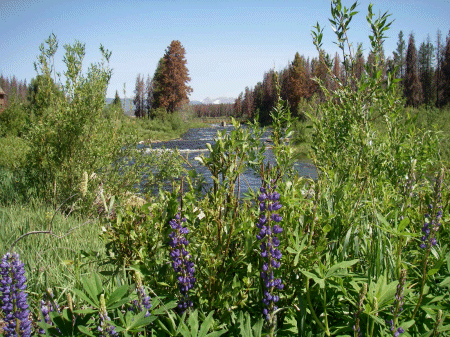
At this point in time the releases are still too strong to allow easy access to most of the stream and the flows are such that finding holding water is difficult.
Once the flows are reduced, fishing here is out of the world for the first few days. We had a memorable experience last year when we inadvertently timed that visit perfectly.
Today the fishing was typical for higher flows.
In a few spots behind boulders and by the bank, I caught a handful of under twelve inch rainbows, browns, and a single cutbow.
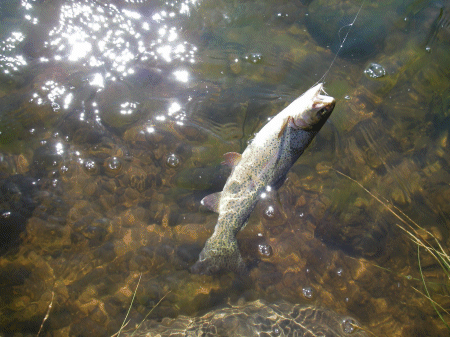
Didn't spend a lot of time here and then debated putting the kayak in either Shadow Mountain or Granby but was anxious to try a new fly on the pike in Williams Fork, so packed up & drove back down Highway 40 to Hot Sulfur Springs, where I did the regular casting to the browns across from the city park.
Water color and flow on the Colorado was much improved from the prior trip, and I had fun with the modest sized browns that sit in the deeper runs or the riffle on the big bend of the river here.
Then it was on to the Williams Fork Reservoir which is now completely full. Off loaded the kayak, rigged up with my "hot" new pike fly and spent the next three hours casting ineffectively along the grassy flats where so many pike set up shop the prior week. Not only did I not see a single fish in the water, but I most certainly did not get a single strike either. Another "F" for me on pike.
Home, Main Fishing Page, , Eagle River Access, Local Ten Commandments, Successful Fly Patterns, Search For Something